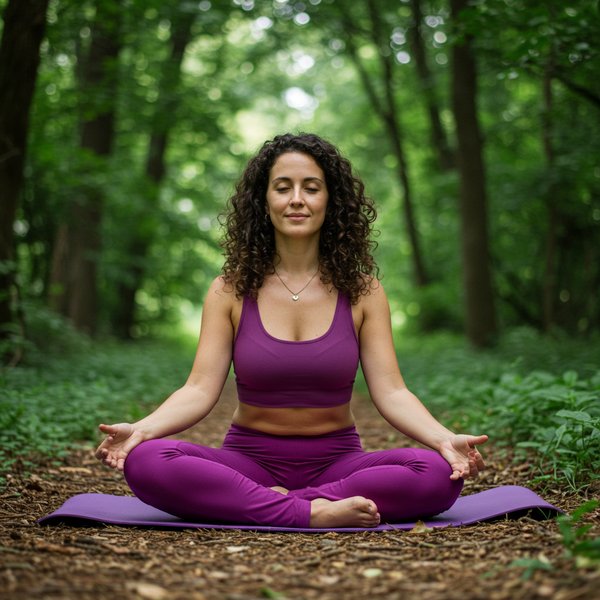Lesson
Introduction to Meditation
Welcome to the world of meditation! This lesson will serve as your guide to understanding the basics of meditation, exploring different types, preparing for a session, and learning some simple techniques to start your practice. Meditation is a powerful tool for reducing stress, improving focus, and enhancing overall well-being.
What is Meditation?
Meditation is a practice where an individual uses a technique – such as mindfulness, or focusing the mind on a particular object, thought, or activity – to train attention and awareness, and achieve a mentally clear and emotionally calm and stable state. It's not about emptying your mind completely; rather, it's about observing your thoughts and feelings without judgment.

Core Concepts of Meditation
Several core concepts underpin the practice of meditation:
- Attention: Learning to focus your attention on a specific point, whether it's your breath, a sound, or a visualization.
- Awareness: Developing a heightened awareness of your thoughts, feelings, and bodily sensations without getting carried away by them.
- Acceptance: Cultivating a non-judgmental attitude towards your experiences.
- Present Moment Focus: Anchoring yourself in the present moment, rather than dwelling on the past or worrying about the future.
Types of Meditation
There are many different types of meditation, each with its own unique approach. Here are a few popular types:
- Mindfulness Meditation: Involves paying attention to your thoughts, feelings, and sensations as they arise, without judgment.
- Focused Attention Meditation: Involves focusing on a single point, such as your breath, a mantra, or a candle flame.
- Loving-Kindness Meditation (Metta): Involves cultivating feelings of love, compassion, and kindness towards yourself and others.
- Transcendental Meditation (TM): Involves using a mantra to quiet the mind and promote relaxation.
- Walking Meditation: Involves paying attention to the sensations of walking, such as the feeling of your feet on the ground.
Preparing for a Meditation Session
Creating a conducive environment can significantly enhance your meditation experience:
- Find a Quiet Space: Choose a place where you won't be disturbed by noise or interruptions.
- Set a Time: Dedicate a specific time each day for meditation. Consistency is key.
- Comfortable Posture: Sit in a comfortable position, either on a cushion, chair, or the floor. Maintain a straight but relaxed posture.
- Minimize Distractions: Turn off your phone, inform others not to disturb you, and eliminate any potential distractions.

Basic Meditation Techniques
Here are two simple techniques to get you started:
Breath Awareness Meditation
- Sit comfortably with your eyes closed or softly focused.
- Bring your attention to your breath. Notice the sensation of the air entering and leaving your body.
- Feel the rise and fall of your abdomen or chest.
- When your mind wanders (and it will!), gently redirect your attention back to your breath.
- Start with 5 minutes and gradually increase the duration as you become more comfortable.
Body Scan Meditation
- Lie down or sit comfortably with your eyes closed.
- Bring your attention to different parts of your body, starting with your toes.
- Notice any sensations you feel in each part of your body – warmth, tingling, pressure, or nothing at all.
- Move your attention slowly up your body, from your toes to your head.
- If you encounter any discomfort or pain, simply acknowledge it without judgment and continue the scan.
- Practice for 10-15 minutes.
Dealing with a Wandering Mind
It's perfectly normal for your mind to wander during meditation. Don't get discouraged! When you notice your thoughts drifting, gently acknowledge them without judgment and redirect your attention back to your chosen focus (e.g., your breath). Think of it like training a puppy – it takes patience and persistence.
Benefits of Meditation
Regular meditation practice offers a wide range of benefits, including:
- Reduced stress and anxiety
- Improved focus and concentration
- Enhanced emotional regulation
- Increased self-awareness
- Better sleep quality
- Lower blood pressure
Consistency is Key
Like any skill, meditation requires practice. Aim for consistency, even if it's just for a few minutes each day. Over time, you'll find it easier to quiet your mind and experience the benefits of meditation. Start small and gradually increase the duration of your sessions as you become more comfortable.
Experiment and Explore
Don't be afraid to experiment with different types of meditation and find what works best for you. There's no one-size-fits-all approach. Explore guided meditations, attend a local meditation class, or try using a meditation app. The key is to find a practice that you enjoy and that fits into your lifestyle.
Patience and Persistence
Meditation is a journey, not a destination. Be patient with yourself and don't expect immediate results. It takes time and practice to develop a consistent meditation practice. Just keep showing up, day after day, and you'll gradually experience the transformative benefits of meditation.
Mindfulness in Daily Life
Extend the principles of meditation into your daily life. Practice being present and mindful in your everyday activities, such as eating, walking, or talking to others. Pay attention to your senses and notice the details of your surroundings. By cultivating mindfulness throughout your day, you can experience greater peace, joy, and connection.












